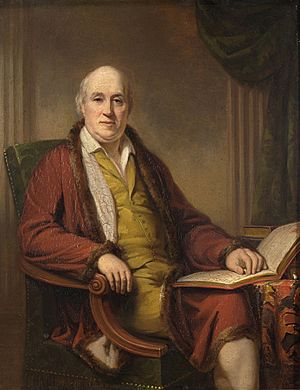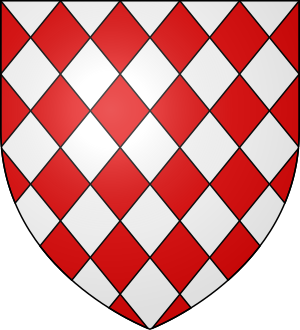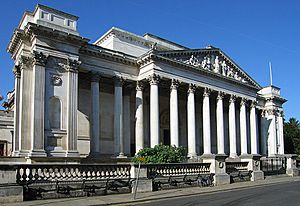Richard FitzWilliam, 7th Viscount FitzWilliam facts for kids
Richard FitzWilliam, 7th Viscount FitzWilliam (born August 1, 1745 – died February 4, 1816) was an important person from Ireland and England. He lived at Mount Merrion in Dublin, Ireland, and in Richmond, Surrey, England.
He was a nobleman who loved music and old things. He started the famous Fitzwilliam Museum in Cambridge, England. He gave his large library and art collection to the museum.
Richard FitzWilliam also helped develop parts of Dublin city. He was a Member of Parliament for Wilton in England from 1790 until he died.
Contents
Family Background
Richard FitzWilliam was born on August 22, 1745. He was the oldest son of Richard FitzWilliam, 6th Viscount FitzWilliam (1711-1776). His mother was Catherine Decker.
Early Family History
The FitzWilliam family in Ireland seems to be different from the English FitzWilliam family. However, some stories say they split up during the time of King Richard II (1154-1189). A family member supposedly went to Ireland with Prince John.
The coats of arms for both families look the same. They were first used around 1200-1215. The design is "Lozengy argent and gules," which means a pattern of silver and red diamond shapes.
The Irish FitzWilliam family has been in Dublin since the 1200s. They became very rich and owned a lot of land in the area. They did this by being smart in business and marrying into wealthy families.
His Life and Work
Richard FitzWilliam studied at Trinity Hall, Cambridge in England. He earned a Master of Arts degree in 1764.
When his father died in 1776, Richard became the 7th Viscount FitzWilliam. In 1789, he became a member of the Royal Society, a group for important scientists.
He was also elected as a Member of Parliament for Wilton in Wiltshire. He served in this role from 1790 to 1806.
Where He Lived
Richard FitzWilliam often visited Mount Merrion House near Dublin. But he mostly lived at FitzWilliam House in Richmond, Surrey, which is west of London. This is where he built his large art collection.
He left his house to his cousin's son, George Herbert, 11th Earl of Pembroke. The house was later renamed "Pembroke House." Today, the area has houses called "Pembroke Villas."
Richard inherited this estate from his mother, Catherine Decker. An old book from 1722-1723 described the Decker estate in Richmond. It mentioned a very tall holly hedge and other evergreen hedges. It also had fountains, a canal, and a special house for ducks. There were also heated greenhouses for growing plants from other countries.
Another book from 1723 talked about growing pineapples at Sir Matthew Decker's estate. The gardener, Mr. Henry Telende, was very good at it. He grew many pineapples, some as big as those from the West Indies. This showed how skilled the gardeners were.
Developing Dublin
Richard FitzWilliam helped develop parts of south-east Dublin. He used the Georgian style, which was popular at the time. Here are some of his projects:
- In 1791, he helped pass a law to enclose the center of Merrion Square. This made it a private garden for residents.
- He planned Fitzwilliam Square starting in 1789. It was laid out in 1792.
- In 1812, he helped build a new Roman Catholic church in Booterstown. It was called the Church of the Assumption.
- In 1813, he helped pass a law to enclose the center of Fitzwilliam Square, similar to Merrion Square.
Death and Legacy
Richard FitzWilliam died on February 4, 1816, in London. A few months before, he had fallen off a ladder in his library and hurt his knee. He was buried at St Mary Magdalene, Richmond. His monument is still there on an outside wall.
Since he did not have children who could inherit his title, his younger brothers became Viscount FitzWilliam after him. First, John FitzWilliam, 8th Viscount FitzWilliam (1752–1830), and then Thomas FitzWilliam, 9th Viscount FitzWilliam (1755–1833). When Thomas died in 1833 without children, the title ended.
Richard FitzWilliam left his large Irish lands to George Herbert, 11th Earl of Pembroke (1759-1827), who was his first cousin's son. He gave his amazing art collection and library to the University of Cambridge. He also left money to build a home for them. This became the famous Fitzwilliam Museum.
See also
- Viscount FitzWilliam
Sources
- Hansard 1803–2005: contributions in Parliament by Richard FitzWilliam
| Parliament of the United Kingdom (1801–present) | ||
|---|---|---|
| Preceded by William Gerard Hamilton |
Member of Parliament for Wilton 1790–1800 With: Lord Herbert to 1794 Philip Goldsworthy from 1794 |
Succeeded by Parliament of the United Kingdom |
| Parliament of the United Kingdom (1801–present) | ||
| Preceded by Parliament of Great Britain |
Member of Parliament for Wilton 1801 – Feb 1806 With: Philip Goldsworthy to 1801 John Spencer 1801–1800 Ralph Sheldon from 1804 |
Succeeded by Charles Herbert |
| Peerage of Ireland | ||
| Preceded by Richard Fitzwilliam |
Viscount FitzWilliam 1776–1816 |
Succeeded by John FitzWilliam |






